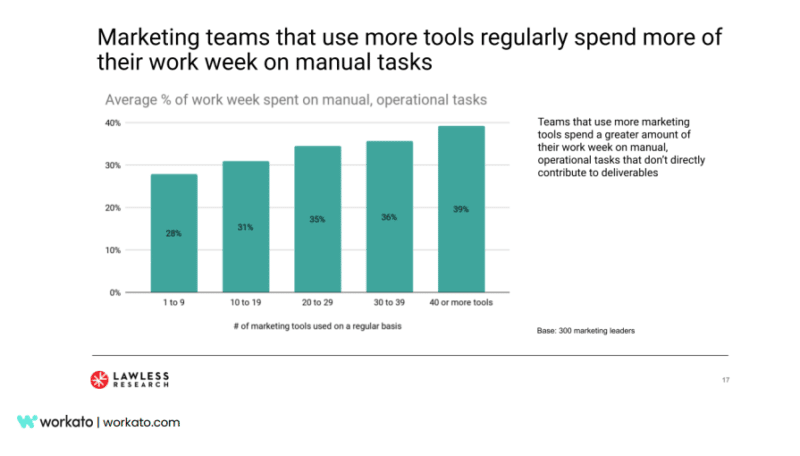Virtually all marketing activities have gone digital in recent years. Technological upgrades, such as marketing automation, have improved campaign efficiency and effectiveness. Yet many marketers find the increasing complexity offputting.
“We know that it’s a super crowded landscape of technology that exists for marketers, and I think the important thing here is we often look at this as a bad thing; it’s really not,” said Stephen Farnsworth, Head of RevOps Product Marketing at Workato, in his recent MarTech presentation. “There’s really just thousands of technologies that solve very specific pains, and I think that’s a really positive thing that that tech exists to be able to solve very niche problems.”
He added, “But it is really confusing and it’s difficult.”
More technology options aren’t enough to transform marketing operations teams. Farnsworth pointed to marketing research from Lawless Research that found manual tasks actually increased as tool adoption grew.

“This data is showing that as more technology is purchased, a greater percentage of time marketing ops teams, or really any operational teams are spending a greater percentage of their time supporting this technology, which results in a lot of a huge percentage of time spent on manual operational tasks.”
He added, “What you see is more and more manual operational times spent by teams, which takes them away from the opportunities that actually drive revenue.”
Marketing automation remains an important piece of ops teams, but the changing digital landscape necessitates complementary solutions.
Growth through marketing automation and integration
Teams shouldn’t use marketing automation platforms as plug-and-go solutions. They should be fully integrated into workflows so campaign data can be used most effectively.
“This kind of disconnected data, disconnected teams, specialized roles, and disconnected tech creates a lot of confusion for customers, sellers, and the OPS teams,” said Farnsworth. “Integration and automation really helps to connect that data and connect those teams through automated processes.”

Using marketing automation to better manage leads
Lead management can be a big issue for brands if they fail to offer a frictionless intake process, a problem that’s widespread. For instance, only 7% of B2B companies responded to leads in five minutes or less in Drift’s Lead Response Report.
“I think we all know it needs to be super frictionless and needs to take very little time for it to be something that you know established a strong lead conversion,” said Farnsworth. “Frankly, no matter what the automation is, if you actually have a process that you can document, that’s really the place to start.”
Personalizing campaigns with account-based marketing
B2B marketing ops know account-based marketing can help personalize customer campaigns and gather intent data. But despite its importance, ABM findings will be rendered useless if not made actionable.
“It’s still a big thing that people quite haven’t quite figured out. I think everyone sees that it’s important,” said Farnsworth. “But it’s still very hard to make actionable.”
Ops teams can coordinate their ABM strategy with automation platforms to track, enrich, and act on buyer data.
Product led growth strategies
One of the biggest obstacles in marketing team efforts is the lack of accessible data. Making it available to all team members allows campaigns to leverage products and gain behavioral insights. And focusing on the product and its benefits creates alignment across operation teams.
“And that’s the thing,” said Farnsworth, “getting the right people involved across the different tools and making sure the data can be integrated into one common source or into reports that can be easily accessed for the right teams.”
Watch the full presentation from our MarTech conference here (free registration required).
Snapshot: Marketing automation
For today’s marketers, automation platforms are often the center of the marketing stack. They aren’t shiny new technologies, but rather dependable stalwarts that marketers can rely upon to help them stand out in a crowded inbox and on the web amidst a deluge of content.
HubSpot noted late last year that marketing email volume had increased by as much as 52% compared to pre-COVID levels. And, thankfully, response rates have also risen to between 10% and 20% over their benchmark.
To help marketers win the attention battle, marketing automation vendors have expanded from dependence on static email campaigns to offering dynamic content deployment for email, landing pages, mobile and social. They’ve also incorporated features that rely on machine learning and artificial intelligence for functions such as lead scoring, in addition to investing in the user interface and scalability.
The growing popularity of account-based marketing has also been a force influencing vendors’ roadmaps, as marketers seek to serve the buying group in a holistic manner — speaking to all of its members and their different priorities. And, ideally, these tools let marketers send buyer information through their tight integrations with CRMs, giving the sales team a leg up when it comes to closing the deal. Learn more here.
The post What automation looks like in marketing operations today appeared first on MarTech.

0 Comments